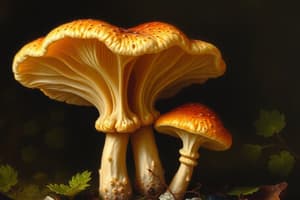Podcast
Questions and Answers
Which of the following antifungal agents acts by blocking ergosterol synthesis through inhibition of 14-α demethylase?
Which of the following antifungal agents acts by blocking ergosterol synthesis through inhibition of 14-α demethylase?
- Nystatin
- Micafungin
- Fluconazole (correct)
- Amphotericin B
What is a significant risk factor for acquiring systemic candidiasis?
What is a significant risk factor for acquiring systemic candidiasis?
- Antifungal prophylaxis
- Immunosuppression (correct)
- Isolation of patients
- Regular hand hygiene
Which antifungal medication is not effective against cryptococcosis or moulds?
Which antifungal medication is not effective against cryptococcosis or moulds?
- Fluconazole
- Amphotericin B
- Clotrimazole
- Micafungin (correct)
Which of the following is a key infection prevention measure specifically indicated for patients susceptible to Candida auris?
Which of the following is a key infection prevention measure specifically indicated for patients susceptible to Candida auris?
What is the main mechanism by which Amphotericin B exerts its antifungal effects?
What is the main mechanism by which Amphotericin B exerts its antifungal effects?
Which type of mycoses primarily involves keratin-containing structures and is usually not life-threatening?
Which type of mycoses primarily involves keratin-containing structures and is usually not life-threatening?
Which organism is primarily responsible for invasive candidiasis?
Which organism is primarily responsible for invasive candidiasis?
What is a common environmental trigger for subcutaneous mycoses?
What is a common environmental trigger for subcutaneous mycoses?
What is the primary predisposing factor for opportunistic mycoses?
What is the primary predisposing factor for opportunistic mycoses?
Which method is primarily used for laboratory diagnosis of fungal infections?
Which method is primarily used for laboratory diagnosis of fungal infections?
What role do antifungal medications play in treating fungal infections?
What role do antifungal medications play in treating fungal infections?
Which of the following risk factors is associated with an increased likelihood of developing systemic mycoses?
Which of the following risk factors is associated with an increased likelihood of developing systemic mycoses?
What is the significance of Sabouraud dextrose agar in mycology?
What is the significance of Sabouraud dextrose agar in mycology?
Which factor is NOT considered a predisposing factor for fungal infections?
Which factor is NOT considered a predisposing factor for fungal infections?
What characteristic distinguishes yeast from moulds?
What characteristic distinguishes yeast from moulds?
What is one way Candida species evade the immune system?
What is one way Candida species evade the immune system?
Which of the following is NOT a common form of reproduction for fungi?
Which of the following is NOT a common form of reproduction for fungi?
In what scenario would superficial mycoses typically become more problematic?
In what scenario would superficial mycoses typically become more problematic?
Which of these factors most affects the prevention of fungal infections?
Which of these factors most affects the prevention of fungal infections?
Flashcards
Fungal infection prevention
Fungal infection prevention
Methods to stop fungal infections, including treating the underlying cause, giving preventative meds to those with immune issues, and practicing good hygiene.
Immunosuppression
Immunosuppression
Weakened immune system, making a person more susceptible to infections.
Prophylactic therapy
Prophylactic therapy
Preventative treatment to stop infections from happening, especially in those with weak immune systems.
Hand hygiene
Hand hygiene
Signup and view all the flashcards
Isolation (Candida auris)
Isolation (Candida auris)
Signup and view all the flashcards
Azoles (Fluconazole)
Azoles (Fluconazole)
Signup and view all the flashcards
Ergosterol synthesis
Ergosterol synthesis
Signup and view all the flashcards
Polyenes (Amphotericin B)
Polyenes (Amphotericin B)
Signup and view all the flashcards
Nephrotoxic
Nephrotoxic
Signup and view all the flashcards
Echinocandins (Micafungin)
Echinocandins (Micafungin)
Signup and view all the flashcards
Fungal cell wall
Fungal cell wall
Signup and view all the flashcards
Mycology
Mycology
Signup and view all the flashcards
Eukaryotic organisms
Eukaryotic organisms
Signup and view all the flashcards
Oral mycoses
Oral mycoses
Signup and view all the flashcards
Yeast
Yeast
Signup and view all the flashcards
Moulds
Moulds
Signup and view all the flashcards
Hyphae
Hyphae
Signup and view all the flashcards
Septa
Septa
Signup and view all the flashcards
Conidia
Conidia
Signup and view all the flashcards
Reproduction (fungal)
Reproduction (fungal)
Signup and view all the flashcards
Candida infections
Candida infections
Signup and view all the flashcards
Superficial mycoses
Superficial mycoses
Signup and view all the flashcards
Dermatophytes
Dermatophytes
Signup and view all the flashcards
Subcutaneous mycoses
Subcutaneous mycoses
Signup and view all the flashcards
Systemic mycoses
Systemic mycoses
Signup and view all the flashcards
Opportunistic pathogens
Opportunistic pathogens
Signup and view all the flashcards
Risk factors for fungal infections
Risk factors for fungal infections
Signup and view all the flashcards
Laboratory Diagnosis (Microscopy)
Laboratory Diagnosis (Microscopy)
Signup and view all the flashcards
Laboratory Diagnosis (Culture)
Laboratory Diagnosis (Culture)
Signup and view all the flashcards
Study Notes
Introduction to Fungi
- Mycology is the study of fungi.
- Fungi are eukaryotic organisms.
- Many different types of fungi exist.
- Candida species are most relevant to dentistry.
- Oral mycoses are fungal infections of the oral cavity.
Morphology
- Fungi can exist in various forms including yeast, dimorphic fungi, and mould.
- Yeasts are unicellular, spherical/ovoid cells.
- Molds are multicellular, with thread-like structures called hyphae.
- Hyphae may have cross-walls called septa.
- Fungal structures such as conidiophores and sporangiophores produce conidia/spores (asexual reproductive units) or spores (sexual or asexual).
Reproduction
- Fungi reproduce both sexually and asexually.
- Asexual reproduction involves spore-producing structures.
- Sexual reproduction involves fusion of cytoplasm and nuclei.
Pathogenicity
- Medically important fungi generally cause slow-progressing, chronic infections.
- Candida species adhere to host tissues, form biofilms, and modify surface antigens, enabling immune evasion and tissue destruction.
- They produce enzymes like phospholipase, proteinase, and haemolysin to cause tissue destruction.
Human Mycoses
- Human fungal infections are categorized as superficial, subcutaneous, and systemic.
Superficial Mycoses
- Affect mucosal surfaces and keratin-containing structures (skin, nails, hair).
- These infections are relatively common and are often cosmetic problems, not life-threatening.
- Common causes include Candida species and dermatophytes (tinea/ringworm).
Subcutaneous Mycoses
- Infection of the subcutaneous tissue.
- Often result from environmental fungi entering the tissue through trauma.
- May cause chronic, progressive disease, tissue destruction, and sinus formation.
- Examples are sporotrichosis and eumycetoma.
Systemic Mycoses
- The most serious and often fatal form of mycoses.
- Involve the body's internal organ systems.
- Common among immunocompromised patients—patients with organ transplants, prosthetic devices, ICU patients, HIV/AIDS, long-term steroid use, or malignancies.
- Examples include cryptococcosis, histoplasmosis, invasive candidiasis, and invasive aspergillosis.
Opportunistic Mycoses
- Opportunistic pathogens—fungi that are normally harmless—cause disease in immunocompromised patients.
- These fungi are typically found in the body's normal flora.
- Predisposing factors include reduced cell-mediated immunity, altered skin/mucus membrane integrity, or suppression of normal flora by antibiotics.
Risk Factors for Fungal Infections
- HIV/AIDS (especially advanced stages)
- Organ transplant patients
- Patients with malignancies
- Patients with autoimmune disorders (like SLE)
- Diabetes mellitus
- Use of immunosuppressive agents (cytotoxic agents, corticosteroids)
- Prolonged antibiotic use
- Travelers/inhabitants of regions with endemic mycoses
Laboratory Diagnosis
- Accurate diagnosis requires proper collection and transport of specimens to the microbiology lab.
- Fungi grow slowly, thus delays in transport lead to overgrowth and inaccurate isolation.
- Common specimens include respiratory tract, hair, skin, nails, blood, CSF, aspirates, and tissue.
Laboratory Diagnosis - Microscopy
- Direct microscopy is performed to identify fungal elements in collected specimens.
- Common stains include Gram stain and KOH.
Laboratory Diagnosis - Culture
- Medically important fungi have varied growth requirements compared to bacteria.
- Sabouraud dextrose agar is often used to isolate fungi.
- This medium has a high carbohydrate content and low pH, inhibiting bacterial growth.
- Antibiotics may be added to further suppress bacterial growth.
Prevention of Fungal Infections
- Prevention is better than cure.
- Methods to prevent fungal infections include treatment of underlying immunosuppression, prophylactic therapy for immunocompromised patients, and infection prevention/control measures such as hand hygiene or isolation of selected patients.
Antifungal Agents
- Antifungals target different mechanisms to stop fungal growth and include polyenes, azoles, echnocandins, allylamines, and other agents.
- Mechanism of action varies, such as targeting cell membrane damage or inhibiting cell wall synthesis.
Antifungal Agents - Specific Example (Fluconazole)
- Blocks ergosterol synthesis by inhibiting 14-α-demethylase.
- Used for oropharyngeal, vaginal, oesophageal candidiasis; systemic candidiasis, prophylaxis for invasive candidiasis; and treatment/prophylaxis of cryptococcal meningitis.
Antifungal Agents - Specific Example (Amphotericin B)
- Forms complexes with ergosterol, disrupting the fungal cell membrane, causing cytoplasmic leakage, and cell death.
- Used to treat serious systemic infections like systemic candidiasis, cryptococcal meningitis, blastomycosis, histoplasmosis, and coccidioidomycosis.
Antifungal Agents - Specific Example (Micafungin)
- Inhibits fungal cell wall synthesis by inhibiting 1,3 beta-D-glucan synthase.
- Used for systemic candidiasis and severe systemic infections, but not effective against Cryptococcosis and molds.
Studying That Suits You
Use AI to generate personalized quizzes and flashcards to suit your learning preferences.




